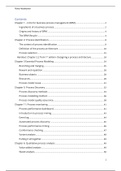Summary
Extensive summary of 1BM05 book "Fundamentals of Business Process Management" 2nd Edition (M.Dumas et al.)
- Course
- Institution
- Book
Extensive summary of the 1BM05 book covering all chapters and additionally parts from 1st edition chapters 2 and 8 as required by study guide 2019/2020. Covers topics on a deeper level than most summaries. See TOC for more chapter details.
[Show more]




